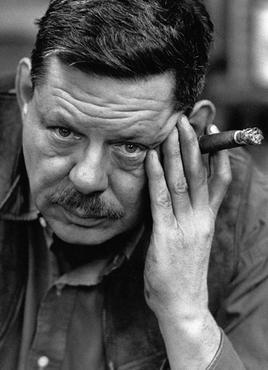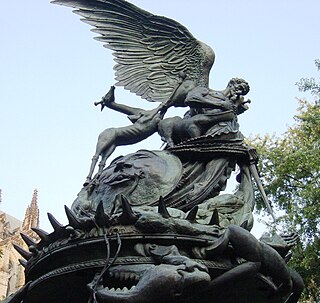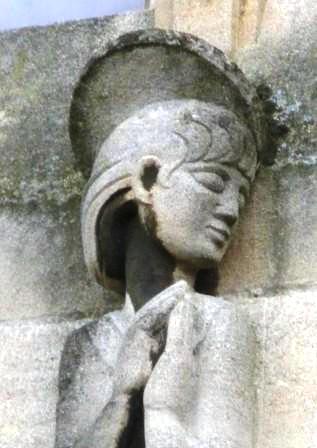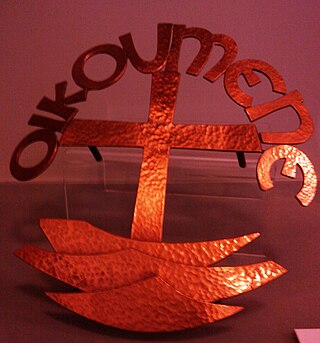
Sir Anthony Alfred Caro was an English abstract sculptor whose work is characterised by assemblages of metal using 'found' industrial objects. He began as a member of the modernist school, having worked with Henry Moore early in his career. He was lauded as the greatest British sculptor of his generation.
Events from the year 1962 in art.

Roland David Smith was an influential and innovative American abstract expressionist sculptor and painter, best known for creating large steel abstract geometric sculptures. Born in Decatur, Indiana, Smith initially pursued painting, receiving training at the Art Students League in New York from 1926 to 1930. However, his artistic journey took a transformative turn in the early 1930s when he shifted his focus to sculpture.

Don Gummer is an American sculptor. His early work concentrated on table-top and wall-mounted sculpture. In the mid-1980s, he shifted his focus to large free-standing works, often in bronze. In the 1990s, he added a variety of other materials, such as stainless steel, aluminum and stained glass. His interest in large outdoor works also led him to an interest in public art. He is the husband of actress Meryl Streep.
Constantin Lucaci was a Romanian contemporary sculptor, best known for his monumentalist sculptures and his kinetic fountains most made from stainless steel, among which those from the Romanian cities of Reșița and Constanța are best known. He was born in Bocșa Română, today a part of Bocșa, Caraș-Severin County.

Dhruva Mistry is an Indian sculptor.

Greg Wyatt is an American representational sculptor who works primarily in cast bronze, and is the sculptor-in-residence at the Cathedral Church of St. John the Divine in New York City.
Roger White Stoller is an American sculptor who specializes in large works integrating stainless steel, bronze and granite. He currently works out of studios in Portola Valley and San Jose, California.

Dennis Huntley, born in Weybridge in Surrey, England, is a British sculptor, furniture designer and author. A Fellow of the Royal British Society of Sculptors, he has completed works for cathedrals, individual collectors and other organisations. Among his most notable works are his sculptures for Guildford Cathedral.

Charles William George Hadcock is a British sculptor known for his monumental sculptures that incorporate elements of geology, engineering, and mathematics. Hadcock's work also draws inspiration from music, philosophy, and poetry. He is a Deputy Lieutenant of Lancashire.
Tim Scott is a British sculptor known for his abstract sculptures made from transparent acrylic and steel. While studying architecture, Scott also studied sculpture part-time at Saint Martin's School of Art with Sir Anthony Caro, where he also later taught. Inspired by the example of David Smith, Scott began to make sculptures using materials such as fibreglass, glass, metal, and acrylic sheets.

Ronald Pope was an English sculptor and artist.
Angela Conner FRSS is an English sculptor who works in London. Conner has exhibited internationally and has large scale sculptures in public and private collections around the world.
William George Mitchell was an English sculptor, artist and designer. He is best known for his large scale concrete murals and public works of art from the 1960s and 1970s. His work is often of an abstract or stylised nature with its roots in the traditions of craft and "buildability". His use of heavily modelled surfaces created a distinctive language for his predominantly concrete and glass reinforced concrete (GRC) sculptures. After long years of neglect, many of William Mitchell's remaining works in the United Kingdom are now being recognised for their artistic merit and contemporary historic value, and have been granted protective, listed status.
Danny Lane is an American artist, best known for his glass and steel sculpture. Lane is also known for his work in art furniture and contemporary design. He lives and works in London.
Mark Reed is a British sculptor based in East Anglia, in the United Kingdom. Reed works primarily in metals, using bronze, mild steel, stainless steel and aluminium. According to Reed, his themes include "nature and his place within it, science, the environment, family and the passage of time."

Hans Van de Bovenkamp is a Dutch-born American sculptor. Van de Bovenkamp was born in Garderen, Holland in 1938 and immigrated to the United States in 1958. He is best known for his large scale abstract work in bronze, stainless steel, painted steel, and aluminum. Van de Bovenkamp's works are often influenced by myth, symbol, and nature. He is a member of the International Sculpture Center, the New York Sculptors Guild, and the Royal Society of British Sculptors.
Sam Shendi is an Egyptian-born, British sculptor. He uses contemporary industrial material, steel, stainless steel, aluminium and fibreglass to create his figurative work. He lives and works in North Yorkshire.

Brian Wall is a British-born American sculptor now living in California. His work consists mainly of abstract welded steel constructions, and his career stretches over six decades. He has had numerous solo shows, and his sculptures reside in many private and museum collections. He was a faculty member at the Central School of Art in London, and a professor of art at the University of California, Berkeley.









